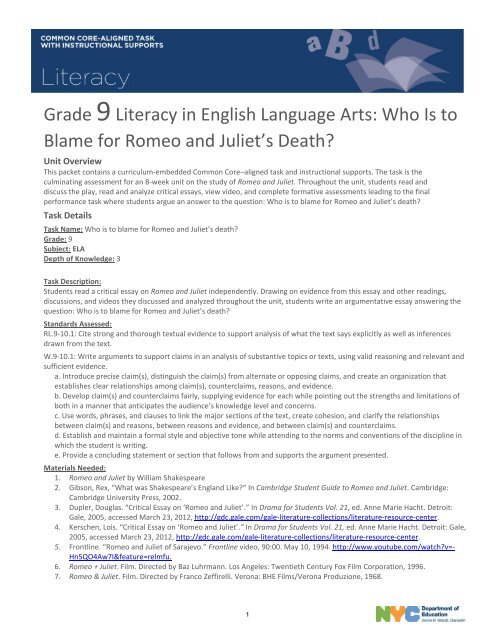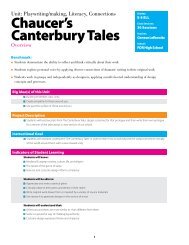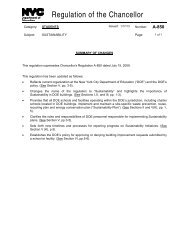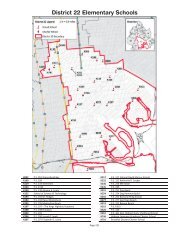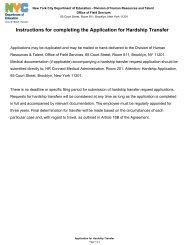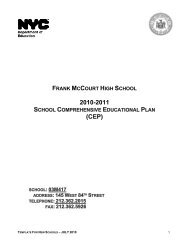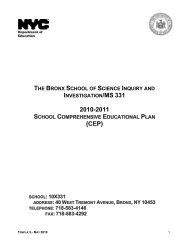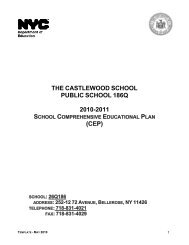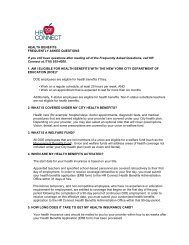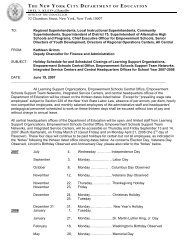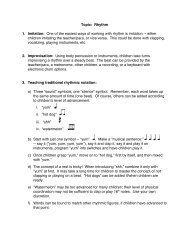Who Is to Blame for Romeo and Juliet's Death? - New York City ...
Who Is to Blame for Romeo and Juliet's Death? - New York City ...
Who Is to Blame for Romeo and Juliet's Death? - New York City ...
You also want an ePaper? Increase the reach of your titles
YUMPU automatically turns print PDFs into web optimized ePapers that Google loves.
Grade 9 Literacy in English Language Arts: <strong>Who</strong> <strong>Is</strong> <strong>to</strong><br />
<strong>Blame</strong> <strong>for</strong> <strong>Romeo</strong> <strong>and</strong> Juliet’s <strong>Death</strong>?<br />
Unit Overview<br />
This packet contains a curriculum-embedded Common Core–aligned task <strong>and</strong> instructional supports. The task is the<br />
culminating assessment <strong>for</strong> an 8-week unit on the study of <strong>Romeo</strong> <strong>and</strong> Juliet. Throughout the unit, students read <strong>and</strong><br />
discuss the play, read <strong>and</strong> analyze critical essays, view video, <strong>and</strong> complete <strong>for</strong>mative assessments leading <strong>to</strong> the final<br />
per<strong>for</strong>mance task where students argue an answer <strong>to</strong> the question: <strong>Who</strong> is <strong>to</strong> blame <strong>for</strong> <strong>Romeo</strong> <strong>and</strong> Juliet’s death?<br />
Task Details<br />
Task Name: <strong>Who</strong> is <strong>to</strong> blame <strong>for</strong> <strong>Romeo</strong> <strong>and</strong> Juliet’s death?<br />
Grade: 9<br />
Subject: ELA<br />
Depth of Knowledge: 3<br />
Task Description:<br />
Students read a critical essay on <strong>Romeo</strong> <strong>and</strong> Juliet independently. Drawing on evidence from this essay <strong>and</strong> other readings,<br />
discussions, <strong>and</strong> videos they discussed <strong>and</strong> analyzed throughout the unit, students write an argumentative essay answering the<br />
question: <strong>Who</strong> is <strong>to</strong> blame <strong>for</strong> <strong>Romeo</strong> <strong>and</strong> Juliet’s death?<br />
St<strong>and</strong>ards Assessed:<br />
RL.9-10.1: Cite strong <strong>and</strong> thorough textual evidence <strong>to</strong> support analysis of what the text says explicitly as well as inferences<br />
drawn from the text.<br />
W.9-10.1: Write arguments <strong>to</strong> support claims in an analysis of substantive <strong>to</strong>pics or texts, using valid reasoning <strong>and</strong> relevant <strong>and</strong><br />
sufficient evidence.<br />
a. Introduce precise claim(s), distinguish the claim(s) from alternate or opposing claims, <strong>and</strong> create an organization that<br />
establishes clear relationships among claim(s), counterclaims, reasons, <strong>and</strong> evidence.<br />
b. Develop claim(s) <strong>and</strong> counterclaims fairly, supplying evidence <strong>for</strong> each while pointing out the strengths <strong>and</strong> limitations of<br />
both in a manner that anticipates the audience’s knowledge level <strong>and</strong> concerns.<br />
c. Use words, phrases, <strong>and</strong> clauses <strong>to</strong> link the major sections of the text, create cohesion, <strong>and</strong> clarify the relationships<br />
between claim(s) <strong>and</strong> reasons, between reasons <strong>and</strong> evidence, <strong>and</strong> between claim(s) <strong>and</strong> counterclaims.<br />
d. Establish <strong>and</strong> maintain a <strong>for</strong>mal style <strong>and</strong> objective <strong>to</strong>ne while attending <strong>to</strong> the norms <strong>and</strong> conventions of the discipline in<br />
which the student is writing.<br />
e. Provide a concluding statement or section that follows from <strong>and</strong> supports the argument presented.<br />
Materials Needed:<br />
1. <strong>Romeo</strong> <strong>and</strong> Juliet by William Shakespeare<br />
2. Gibson, Rex, “What was Shakespeare’s Engl<strong>and</strong> Like?“ In Cambridge Student Guide <strong>to</strong> <strong>Romeo</strong> <strong>and</strong> Juliet. Cambridge:<br />
Cambridge University Press, 2002.<br />
3. Dupler, Douglas. “Critical Essay on ‘<strong>Romeo</strong> <strong>and</strong> Juliet’.” In Drama <strong>for</strong> Students Vol. 21, ed. Anne Marie Hacht. Detroit:<br />
Gale, 2005, accessed March 23, 2012, http://gdc.gale.com/gale-literature-collections/literature-resource-center.<br />
4. Kerschen, Lois. “Critical Essay on ‘<strong>Romeo</strong> <strong>and</strong> Juliet’.” In Drama <strong>for</strong> Students Vol. 21, ed. Anne Marie Hacht. Detroit: Gale,<br />
2005, accessed March 23, 2012, http://gdc.gale.com/gale-literature-collections/literature-resource-center.<br />
5. Frontline. “<strong>Romeo</strong> <strong>and</strong> Juliet of Sarajevo.” Frontline video, 90:00. May 10, 1994. http://www.youtube.com/watch?v=-<br />
Hn5QO4Aw7I&feature=relmfu.<br />
6. <strong>Romeo</strong> + Juliet. Film. Directed by Baz Luhrmann. Los Angeles: Twentieth Century Fox Film Corporation, 1996.<br />
7. <strong>Romeo</strong> & Juliet. Film. Directed by Franco Zeffirelli. Verona: BHE Films/Verona Produzione, 1968.<br />
1
TABLE OF CONTENTS <br />
The task <strong>and</strong> instructional supports in the following pages are designed <strong>to</strong> help educa<strong>to</strong>rs <br />
underst<strong>and</strong> <strong>and</strong> implement Common Core–aligned tasks that are embedded in a unit of instruction. <br />
We have learned through our pilot work that focusing instruction on units anchored in rigorous <br />
Common Core–aligned assessments drives significant shifts in curriculum <strong>and</strong> pedagogy. <br />
PERFORMANCE TASK: WHO IS TO BLAME?.……………………………………………………………………………...3 <br />
RUBRIC……………………………………………………………………………………………………………………………………..5 <br />
INSTRUCTIONAL SUPPORTS……………………………………………………………………………………………………….7 <br />
UNIT OUTLINE………………………………………………………………………………………………………………….8 <br />
ADDITIONAL INSTRUCTIONAL SUPPORTS …………………………………..……………………………………15 <br />
Acknowledgements: This per<strong>for</strong>mance task <strong>and</strong> unit was developed by a teacher team at NYC public school, K561. It was <br />
reviewed <strong>for</strong> Common Core Alignment by the NYC Common Core Fellows. The unit plan <strong>and</strong> instructional resources are an <br />
amalgamation of many resources <strong>and</strong> teacher ideas. Many of the ideas, lessons, <strong>and</strong> techniques are drawn directly from <br />
resources listed at the end of the unit outline. Attempts have been made <strong>to</strong> cite direct appropriation from another source. In <br />
particular, this unit relies heavily on the Shakespeare Set Free series, The Royal Shakespeare Company Toolkit <strong>for</strong> Teachers, The <br />
Cambridge School Group edition of <strong>Romeo</strong> <strong>and</strong> Juliet, <strong>and</strong> Kelly Gallagher’s superb books on teaching reading <strong>and</strong> writing <strong>to</strong> <br />
adolescents.<br />
2
Grade 9 Literacy in English Language Arts: <strong>Who</strong> <strong>Is</strong> <strong>to</strong> <br />
<strong>Blame</strong> <strong>for</strong> <strong>Romeo</strong> <strong>and</strong> Juliet’s <strong>Death</strong>? <br />
PERFORMANCE TASK <br />
3
Per<strong>for</strong>mance Task <br />
RI.9-‐10.1 Per<strong>for</strong>mance Element: Students independently read a critical essay on <br />
the causes of <strong>Romeo</strong> <strong>and</strong> Juliet’s death. <br />
In your study of <strong>Romeo</strong> <strong>and</strong> Juliet, you have focused on key scenes that highlight the <br />
qu<strong>and</strong>aries <strong>Romeo</strong> <strong>and</strong> Juliet faced. You have analyzed the reasons <strong>for</strong> their choices, <br />
based on the many fac<strong>to</strong>rs that influenced them. You have read others’ opinions <strong>and</strong> <br />
related readings <strong>to</strong> better underst<strong>and</strong> these fac<strong>to</strong>rs. In consideration of what these <br />
many sources communicate about <strong>Romeo</strong> <strong>and</strong> Juliet’s end, <br />
<strong>Who</strong> or what is <strong>to</strong> blame <strong>for</strong> <strong>Romeo</strong> <strong>and</strong> Juliet’s death? <br />
To complete this task successfully you must: <br />
–Argue <strong>for</strong> no more than two fac<strong>to</strong>rs, ranking them by importance in your essay. <br />
–Develop a counterclaim <strong>to</strong> your argument(s) <strong>and</strong> provide evidence <strong>for</strong> it. <br />
–Draw on textual evidence primarily from <strong>Romeo</strong> <strong>and</strong> Juliet, the critical essay that <br />
you read independently, <strong>and</strong> at least one other source from the unit. <br />
W.9-‐10.1 Per<strong>for</strong>mance Element: <br />
Be sure <strong>to</strong>: <br />
–Introduce precise claims, counterclaims, reasons, <strong>and</strong> evidence in a way that is <br />
clear, convincing, <strong>and</strong> considers the audience’s knowledge <strong>and</strong> concerns. <br />
–Make use of transitional words <strong>and</strong> phrases <strong>to</strong> help make the thinking of your <br />
argument clear. <br />
–Base your arguments solely on in<strong>for</strong>mation contained in the texts of your choice. <br />
–Cite strong <strong>and</strong> thorough textual evidence <strong>to</strong> support your argument. <br />
–Use varied <strong>and</strong> effective sentence structure <strong>and</strong> vocabulary. <br />
–Organize your ideas effectively <strong>and</strong> coherently in your writing, including an <br />
introduction that hooks your reader <strong>and</strong> conclusion that leaves your reader thinking. <br />
–Follow the conventions of st<strong>and</strong>ard written English, especially those we have <br />
mastered in our classwork this year. <br />
4
GRADE 9 LITERACY IN ENGLISH LANGUAGE ARTS: <br />
WHO IS TO BLAME? <br />
RUBRIC <br />
This task was scored using a rubric aligned <strong>to</strong> W.9-‐10.1. <br />
5
9-‐10 Writing Argument Rubric <br />
Developing Basic Proficient Exemplary Score <br />
Development of <br />
Argument (Content) <br />
Organization <br />
(Format & Flow) <br />
__ Claim is present <br />
__ Counterclaim is <br />
present <br />
__ Evidence <strong>for</strong> one or <br />
the other <br />
__ Organization is <br />
evident <br />
__ In<strong>for</strong>mation is related <br />
<strong>to</strong> task/<strong>to</strong>pic <br />
__ Claim is developed with <br />
evidence <br />
__ Counterclaim is developed <br />
with evidence <br />
__ Introduction has a <strong>to</strong>pic <br />
sentence that fits task/<strong>to</strong>pic <br />
__ Uses transition between ideas <br />
<strong>and</strong>/or paragraphs <br />
__ Body paragraphs contain <br />
examples related <strong>to</strong> task/<strong>to</strong>pic <br />
__ Concluding paragraph mostly <br />
restates introduction <br />
__ Develops claim with evidence <br />
__ Develops counterclaim clearly <strong>and</strong> <br />
fairly with balanced evidence <br />
__ Counterclaim is distinguishable from <br />
claim <br />
__ Introduction has a <strong>to</strong>pic sentence that <br />
clearly fits task/<strong>to</strong>pic <br />
__ Uses appropriate transitions <strong>to</strong> link <br />
ideas within <strong>and</strong> between paragraphs <br />
__ Body paragraphs contain relevant <strong>and</strong> <br />
specific examples <strong>and</strong>/or details with <br />
clear explanations <br />
__ Concluding paragraph contributes <strong>to</strong> <br />
the cohesion of the overall work <br />
__ Thoroughly develops claim with ample evidence <br />
__ Thoroughly develops counterclaim clearly <strong>and</strong> <br />
fairly with ample <strong>and</strong> balanced evidence <br />
__ Counterclaim is clearly distinguishable from <br />
claim <br />
__ Presents strengths <strong>and</strong> limitations of claim <strong>and</strong> <br />
counterclaim <br />
__ Introduction has a <strong>to</strong>pic sentence that explicitly <br />
fits task/<strong>to</strong>pic <br />
__ Uses sophisticated transitions <strong>to</strong> link <strong>and</strong> build <br />
ideas within <strong>and</strong> between paragraphs <br />
__ Body paragraphs contain relevant <strong>and</strong> specific <br />
examples <strong>and</strong>/or details with thorough <strong>and</strong> logical <br />
explanations <br />
__ Powerful concluding paragraph enhances the <br />
cohesion of the overall work <br />
Craft <br />
(Language Use / <br />
Style) <br />
__ Simple sentences <br />
__ Use of content-‐ <br />
specific vocabulary <br />
__ Style is discernable <br />
__ Simple <strong>and</strong> compound __ Simple, compound, <strong>and</strong> complex <br />
sentences <br />
sentences <br />
__ Appropriate use of content-‐ __ Use of content-‐specific vocabulary <strong>to</strong> <br />
specific vocabulary <br />
help reader underst<strong>and</strong> <strong>and</strong> appreciate <br />
__ Basic style that fits task/<strong>to</strong>pic; the <strong>to</strong>pic <br />
basic voice <strong>and</strong> <strong>to</strong>ne <br />
__ Style fits the purpose of task/<strong>to</strong>pic; <br />
appropriate voice <strong>and</strong> <strong>to</strong>ne <br />
__ Simple, compound, complex, <strong>and</strong> compound-complex<br />
sentences <br />
__ Use of interdisciplinary, content-‐specific <br />
vocabulary <strong>to</strong> help reader underst<strong>and</strong> <strong>and</strong> <br />
appreciate the <strong>to</strong>pic <br />
__ Style fits the purpose of task/<strong>to</strong>pic; strong voice <br />
<strong>and</strong> clear, objective, <strong>and</strong> appropriate <strong>to</strong>ne <br />
Conventions <br />
__ Developing use of <br />
capitalization <strong>and</strong> <br />
punctuation <br />
__ Paragraph <strong>for</strong>mation <br />
<strong>and</strong> no use of citations <br />
__ Basic use of capitalization, <br />
punctuation, <strong>and</strong> grammar <br />
__ Format <strong>and</strong>/or partial use of <br />
citations <br />
__ Proficient use of capitalization, <br />
punctuation, grammar, <strong>and</strong> proofread-ing<br />
<br />
__ Complete <strong>for</strong>mat <strong>and</strong> use of citations <br />
__ Exemplary use of capitalization, punctuation, <br />
grammar, <strong>and</strong> proofreading <br />
__ Comm<strong>and</strong> of <strong>for</strong>mat <strong>and</strong> proper use of citations <br />
Total Score <br />
6
GRADE 9 LITERACY IN ENGLISH LANGUAGE <br />
ARTS: WHO IS TO BLAME? <br />
INSTRUCTIONAL SUPPORTS <br />
The instructional supports on the following pages include a unit outline with <strong>for</strong>mative assessments <strong>and</strong> <br />
suggested learning activities. Teachers may use this unit outline as it is described, integrate parts of it in<strong>to</strong> a <br />
currently existing curriculum unit, or use it as a model or checklist <strong>for</strong> a currently existing unit on a different <br />
<strong>to</strong>pic. <br />
7
Unit Outline<br />
INTRODUCTION: This unit outline provides an example of how <strong>to</strong> integrate per<strong>for</strong>mance tasks in<strong>to</strong> a<br />
unit. Teachers may (a) use this unit outline as it is described below; (b) integrate parts of it in<strong>to</strong> a<br />
currently existing curriculum unit; or (c) use it as a model or checklist <strong>for</strong> a currently existing unit on a<br />
different <strong>to</strong>pic. The length of the unit includes suggested time spent on the classroom instruction of lessons<br />
<strong>and</strong> administration of assessments. Please note that this framework does not include individual lessons.<br />
Grade 9 Literacy in English Language Arts: <strong>Who</strong> <strong>Is</strong> <strong>to</strong> <strong>Blame</strong> <strong>for</strong><br />
<strong>Romeo</strong> <strong>and</strong> Juliet’s <strong>Death</strong>?<br />
UNIT TOPIC AND LENGTH:<br />
‣ This contains a curriculum-embedded Common Core–aligned task <strong>and</strong> instructional<br />
supports. The task is the culminating assessment <strong>for</strong> an 8-week unit on the study of<br />
<strong>Romeo</strong> <strong>and</strong> Juliet. Throughout the unit, students read <strong>and</strong> discuss the play, read <strong>and</strong><br />
analyze critical essays, view video, <strong>and</strong> complete <strong>for</strong>mative assessments leading <strong>to</strong><br />
the final per<strong>for</strong>mance task where students argue an answer <strong>to</strong> the question: <strong>Who</strong> is<br />
<strong>to</strong> blame <strong>for</strong> <strong>Romeo</strong> <strong>and</strong> Juliet’s death?<br />
COMMON CORE LEARNING STANDARDS:<br />
Assessed by the task<br />
RL.9-10.1: Cite strong <strong>and</strong> thorough textual evidence <strong>to</strong> support analysis of what the text<br />
says explicitly, as well as inferences drawn from the text.<br />
W.9-10.1: Write arguments <strong>to</strong> support claims in an analysis of substantive <strong>to</strong>pics or texts,<br />
using valid reasoning <strong>and</strong> relevant <strong>and</strong> sufficient evidence.<br />
a. Introduce precise claim(s), distinguish the claim(s) from alternate or opposing<br />
claims, <strong>and</strong> create an organization that establishes clear relationships among claim(s),<br />
counterclaims, reasons, <strong>and</strong> evidence.<br />
b. Develop claim(s) <strong>and</strong> counterclaims fairly, supplying evidence <strong>for</strong> each while<br />
pointing out the strengths <strong>and</strong> limitations of both in a manner that anticipates the<br />
audience’s knowledge level <strong>and</strong> concerns.<br />
c. Use words, phrases, <strong>and</strong> clauses <strong>to</strong> link the major sections of the text, create<br />
cohesion, <strong>and</strong> clarify the relationships between claim(s) <strong>and</strong> reasons, between reasons<br />
<strong>and</strong> evidence, <strong>and</strong> between claim(s) <strong>and</strong> counterclaims.<br />
d. Establish <strong>and</strong> maintain a <strong>for</strong>mal style <strong>and</strong> objective <strong>to</strong>ne while attending <strong>to</strong> the<br />
norms <strong>and</strong> conventions of the discipline in which the student is writing.<br />
e. Provide a concluding statement or section that follows from <strong>and</strong> supports the<br />
argument presented.<br />
Additional st<strong>and</strong>ards addressed in the unit<br />
RI.9-10.5: Analyze in detail how an author’s ideas or claims are developed <strong>and</strong> refined by<br />
particular sentences, paragraphs, or larger portions of a text (e.g., a section or chapter).<br />
W.9-10.9: Draw evidence from literary or in<strong>for</strong>mational texts <strong>to</strong> support analysis,<br />
reflection, <strong>and</strong> research.<br />
8
W.9-10.10: Write routinely over extended time frames (time <strong>for</strong> research, reflection, <strong>and</strong><br />
revision) <strong>and</strong> shorter time frames (a single sitting or a day or two) <strong>for</strong> a range of tasks,<br />
purposes, <strong>and</strong> audiences.<br />
BIG IDEAS/ENDURING UNDERSTANDINGS:<br />
ESSENTIAL QUESTIONS:<br />
‣ Individuals are influenced by the<br />
society they live in.<br />
‣ Passion can be mistaken <strong>for</strong> love<br />
<strong>and</strong>/or hate.<br />
‣ Our freedom <strong>to</strong> choose may be more<br />
limited by <strong>for</strong>ces acting upon us than<br />
we imagine.<br />
‣ Literary devices such as juxtaposition<br />
<strong>and</strong> imagery help communicate<br />
Shakespeare’s central question:<br />
Which opposing <strong>for</strong>ces most<br />
contributed <strong>to</strong> <strong>Romeo</strong> <strong>and</strong> Juliet’s<br />
death?<br />
‣ Arguments require appropriate<br />
warrants that support claims through<br />
connecting evidence <strong>and</strong> reasons<br />
convincingly.<br />
CONTENT:<br />
‣ Background on the Siege of Sarajevo.<br />
‣ Verona’s 16th-century social class<br />
structure <strong>and</strong> values.<br />
‣ Elizabethan language <strong>and</strong> its often<br />
inverted syntax.<br />
‣ Key literary devices: <strong>for</strong>ms of<br />
contrast (irony, contrast, antithesis,<br />
oxymoron); imagery;<br />
characterization; juxtaposition.<br />
‣ Common camera shots <strong>and</strong> their<br />
traditional interpretations.<br />
<strong>Who</strong> or what is <strong>to</strong> blame <strong>for</strong> <strong>Romeo</strong> <strong>and</strong><br />
<strong>Juliet's</strong> death?<br />
SKILLS:<br />
‣ Does passion help or hinder us?<br />
‣ <strong>Who</strong>se needs should take<br />
precedence: self or society?<br />
‣ Are we in charge of our destiny?<br />
‣ Identify <strong>and</strong> evaluate inferences<br />
within smaller sections of text.<br />
‣ Combine inferences across larger<br />
sections of text <strong>and</strong> consider other<br />
knowledge <strong>to</strong> generate new ideas.<br />
‣ Use sound cause-<strong>and</strong>-effect<br />
reasoning <strong>to</strong> establish a strong claim.<br />
‣ Argue claims based on a complete<br />
view of the evidence <strong>and</strong> a reasoned<br />
connection <strong>to</strong> a warrant.<br />
‣ Summarize the major points an<br />
expert makes; identify how he/she<br />
develops them <strong>and</strong> uses evidence <strong>to</strong><br />
support reasoning.<br />
VOCABULARY/KEY TERMS:<br />
‣ Irony (dramatic <strong>and</strong> situational)<br />
‣ Contrast<br />
‣ Antithesis<br />
‣ Oxymoron<br />
‣ Imagery<br />
9
‣ Characterization<br />
Teachers may wish <strong>to</strong> create a checklist of literary devices <strong>for</strong> students <strong>to</strong> use as a “treasure hunt” as they<br />
read each act (or scene). For some students, teachers might highlight examples in the text <strong>and</strong> ask students<br />
<strong>to</strong> use context clues <strong>to</strong> determine meaning. Such work could be achieved in “Do Nows”, class conversation,<br />
or as a component of an exit slip. Teachers may even wish <strong>to</strong> teach common prefixes, roots, <strong>and</strong> suffixes<br />
where they appear <strong>to</strong> give students greater access <strong>to</strong> tier 2 <strong>and</strong> 3 words: <strong>for</strong> example, the suffix -ity in Act 1<br />
<strong>and</strong> the prefix con- in Act 2.<br />
<strong>Romeo</strong> <strong>and</strong> Juliet Vocabulary<br />
‣ Act 1: ancient, bitterly, envious, fray, grudge, posterity, severity, weary, adversary,<br />
artificial, exquisite, fiery, <strong>for</strong>feit, intrusion, rebellious, virtuous<br />
‣ Act 2: consent, faithfully, glorious, incorporate, perfection, peril, satisfaction,<br />
variable, adjacent, alliance, boundless, courteous, merrily, predominant, sallow,<br />
triumph<br />
‣ Act 3: confines, dishonorable, impatient, mangle, offense, outrage, quarrel, calamity,<br />
disobedient, disposition, predicament, unruly, vile<br />
‣ Act 4: deny, desperate, lamentable, miserable, pitiful, remedy, prosperous<br />
‣ Act 5: contagion, dispose, famine, infectious, loathsome, pestilence, vengeance,<br />
banished, fury, unaccus<strong>to</strong>med, unsavory<br />
ASSESSMENT EVIDENCE AND ACTIVITIES:<br />
INITIAL ASSESSMENT:<br />
Anticipation Guide <strong>and</strong> Exit Slip that ask students <strong>to</strong> reflect on the reasons they have <strong>for</strong><br />
their opinions about big ideas in the play <strong>and</strong> the cause of <strong>Romeo</strong> <strong>and</strong> Juliet’s death (see<br />
Lesson #1).<br />
FORMATIVE ASSESSMENT:<br />
#1, After Text #1 (Prologue–1.3; Critical Essay on Causes)<br />
Based on your readings, create three social rules of Verona <strong>to</strong> present <strong>to</strong> a <strong>for</strong>eign guest.<br />
For each rule, provide a brief explanation <strong>and</strong> rationale. Conclude each explanation with<br />
your ideas about the consequences each rule is likely <strong>to</strong> have on <strong>Romeo</strong> <strong>and</strong> Juliet.<br />
Conclude the assignment with who has the power in Verona: the individual, parents, the<br />
young, or the old. According <strong>to</strong> what we’ve read so far, whose needs come first: the<br />
individual’s or society’s? (In<strong>for</strong>m/Explain)<br />
#2, After Text #2 (1.5–3.2; Critical Essay on the Role of Love)<br />
What are the effects of passion in <strong>Romeo</strong>’s life in <strong>Romeo</strong> <strong>and</strong> Juliet? Identify two emotional<br />
decisions that are most crucial <strong>to</strong> <strong>Romeo</strong>. Analyze the consequences of those decisions,<br />
grounded in textual evidence. Overall, according <strong>to</strong> the events from 1.5–3.2, justify a theme<br />
statement about passion <strong>and</strong> its consequences: is it a friend or foe? (In<strong>for</strong>m/Explain)<br />
#3, After Text #3 (3.3–5.3)<br />
Using your “Play Tracker Chart” (individual choice, society/family pressures, love, hate,<br />
10
fate), create a domino chart that connects the most crucial events, as you see them, that led<br />
<strong>to</strong> <strong>Romeo</strong> <strong>and</strong> Juliet’s death. Categorize these events under no more than two fac<strong>to</strong>rs.<br />
Explain your rationale. (In<strong>for</strong>m/Explain)<br />
FINAL PERFORMANCE TASK:<br />
RI.9-10.1: Per<strong>for</strong>mance Element: Students independently read a critical essay on the<br />
causes of <strong>Romeo</strong> <strong>and</strong> Juliet’s death.<br />
In your study of <strong>Romeo</strong> <strong>and</strong> Juliet, you have focused on key scenes that highlight the<br />
qu<strong>and</strong>aries <strong>Romeo</strong> <strong>and</strong> Juliet faced. You have analyzed the reasons <strong>for</strong> their choices, based<br />
on the many fac<strong>to</strong>rs that influenced them. You have read others’ opinions <strong>and</strong> related<br />
readings <strong>to</strong> better underst<strong>and</strong> these fac<strong>to</strong>rs. In consideration of what these many sources<br />
communicate about <strong>Romeo</strong> <strong>and</strong> Juliet’s end,<br />
<strong>Who</strong> or what is <strong>to</strong> blame <strong>for</strong> <strong>Romeo</strong> <strong>and</strong> Juliet’s death?<br />
To complete this task successfully you must:<br />
‣ Argue <strong>for</strong> no more than two fac<strong>to</strong>rs, ranking them by importance in your essay.<br />
‣ Develop a counterclaim <strong>to</strong> your argument(s) <strong>and</strong> provide evidence <strong>for</strong> it.<br />
‣ Draw on textual evidence primarily from <strong>Romeo</strong> <strong>and</strong> Juliet, the critical essay that you<br />
read independently, <strong>and</strong> at least one other source from the unit.<br />
W.9-10.1 Per<strong>for</strong>mance Element:<br />
Be sure <strong>to</strong>:<br />
‣ Introduce precise claims, counterclaims, reasons, <strong>and</strong> evidence in a way that is clear,<br />
convincing, <strong>and</strong> considers the audience’s knowledge <strong>and</strong> concerns.<br />
‣ Make use of transitional words <strong>and</strong> phrases <strong>to</strong> help make the thinking of your<br />
argument clear.<br />
‣ Base your arguments solely on in<strong>for</strong>mation contained in the texts of your choice.<br />
‣ Cite strong <strong>and</strong> thorough textual evidence <strong>to</strong> support your argument.<br />
‣ Use varied <strong>and</strong> effective sentence structure <strong>and</strong> vocabulary.<br />
‣ Organize your ideas effectively <strong>and</strong> coherently in your writing, including an<br />
introduction that hooks your reader <strong>and</strong> conclusion that leaves your reader<br />
thinking.<br />
‣ Follow the conventions of st<strong>and</strong>ard written English, especially those we have<br />
mastered in our classwork this year.<br />
LEARNING PLAN & ACTIVITIES:<br />
Instructional Approach:<br />
‣ Implement gradual release of reading responsibility in each text, using more time<br />
<strong>and</strong> multiple “readings” of key scenes. Multiple readings will progress from<br />
determining the what, how, <strong>and</strong> why <strong>for</strong> each scene: What is being said? How is<br />
Shakespeare saying it? What is the effect? Why is that important? Be sure <strong>to</strong> support<br />
students in making connections <strong>to</strong> big ideas <strong>and</strong> Common Core st<strong>and</strong>ards-based<br />
enduring underst<strong>and</strong>ings.<br />
11
‣ Underst<strong>and</strong>ing the “what” is often accomplished through dramatic activity; the<br />
“how” <strong>and</strong> “why” through closer reading, text-dependent questions, <strong>and</strong> mostly<br />
teacher-led class conversation.<br />
‣ When beginning the sequence of close readings <strong>for</strong> a given text, the class will do all<br />
readings <strong>to</strong>gether; as the class progresses through the sequence, students will begin<br />
<strong>to</strong> do second <strong>and</strong> third readings in collaborative pairs. For the nonfiction readings,<br />
by the end of Text #3, students will read independently.<br />
‣ Our nonfiction, secondary sources will correlate <strong>to</strong> our frame <strong>for</strong> reading literary<br />
texts: What is the point? How is it being communicated? What is the author’s<br />
purpose <strong>for</strong> writing?<br />
Text #1: <strong>Romeo</strong> <strong>and</strong> Juliet (1490 Lexile), Prologue–1.3<br />
1.<br />
2. “<strong>Romeo</strong> <strong>and</strong> Juliet of Sarajevo” (Frontline, 1994)<br />
3. Prologue, Act 1<br />
‣ 1.1.1–1.1.105 (Civil feuds)<br />
‣ Nonfiction: “What Was Shakespeare’s Engl<strong>and</strong> Like?” (cobbled from two sources)<br />
‣ 1.2–1.3 (Views on love <strong>and</strong> marriage/parents’ influence)<br />
‣ Zeffirelli’s <strong>Romeo</strong> & Juliet (1.1–1.3)<br />
Themes <strong>and</strong> Literary Devices:<br />
Individual vs. society, parental (patriarchal) power, antithesis, dramatic irony, contrast,<br />
characterization<br />
EQ:<br />
<strong>Who</strong> has the power, the individual or society? Which comes first, the individual or society?<br />
Why? How?<br />
Conceptually Related Common Core St<strong>and</strong>ards <strong>and</strong> Learning Targets:<br />
RI.9-10.1 <strong>and</strong> RL.9-10.1:<br />
Student can use multiple details throughout a text <strong>to</strong> generate good points <strong>and</strong> argue them<br />
believably.<br />
RI.9-10.5:<br />
Student can read nonfiction <strong>for</strong> the point an author is making <strong>and</strong> how he/she<br />
communicates it, paying special attention <strong>to</strong> sentences or sections of text that show where<br />
the author builds or shifts his/her ideas.<br />
W.9-10.9:<br />
Student can consider what experts think about a subject <strong>to</strong> develop his/her own ideas.<br />
Text #2: <strong>Romeo</strong> <strong>and</strong> Juliet (1490 Lexile)<br />
‣ 1.5 (Ball scene; love at first sight)<br />
‣ 2.1.1–14 (<strong>Romeo</strong> <strong>and</strong> Juliet’s passion)<br />
‣ 2.2 (The balcony scene)<br />
‣ 3.1 (Big fight, <strong>Romeo</strong> is banished)<br />
‣ 3.2 (Juliet’s mood swings)<br />
‣ 3.5 (Lord Capulet’s rage: “Hang, beg, starve in the streets…”)<br />
‣ Lurhmann’s <strong>Romeo</strong> & Juliet (1.5–3.5)<br />
‣ “Critical Essay on <strong>Romeo</strong> <strong>and</strong> Juliet” [Role of Love] (1270 Lexile)<br />
12
Themes <strong>and</strong> Literary Devices:<br />
Love <strong>and</strong> hate, light/dark imagery, contrast/juxtaposition<br />
EQ:<br />
Does passion help or hinder us? How? Why?<br />
Conceptually Related Common Core St<strong>and</strong>ards <strong>and</strong> Learning Targets:<br />
RI.9-10.1 <strong>and</strong> RL.9-10.1:<br />
Student can use multiple details throughout a text <strong>to</strong> generate good points <strong>and</strong> argue them<br />
believably.<br />
RI.9–10.5:<br />
Student can read nonfiction <strong>for</strong> the point an author is making <strong>and</strong> how he/she<br />
communicates it, paying special attention <strong>to</strong> sentences or sections of text that show where<br />
the author builds or shifts his/her ideas.<br />
W.9–10.9:<br />
Student can consider what experts think about a subject <strong>to</strong> develop his/her own ideas.<br />
Text #3: <strong>Romeo</strong> <strong>and</strong> Juliet (1490 Lexile)<br />
‣ 4.3 (Juliet drinks potion: imagery)<br />
‣ 4.4–5 (Multiple causes)<br />
‣ 5.1–2 (Fate debate)<br />
‣ 5.3.88–5.3.120 (<strong>Romeo</strong>’s final speech)<br />
‣ Lurhmann’s <strong>Romeo</strong> & Juliet (4.3–5.3)<br />
‣ “Critical Essay on <strong>Romeo</strong> <strong>and</strong> Juliet” [Causes of <strong>Death</strong>] (1270 Lexile)<br />
Themes <strong>and</strong> Literary Devices:<br />
Fate <strong>and</strong> free will, imagery contrast, irony<br />
EQ:<br />
Are we in charge of our destiny?<br />
Conceptually Related CCL st<strong>and</strong>ards <strong>and</strong> Learning Targets:<br />
RI.9-10.1 <strong>and</strong> RL.9-10.1:<br />
Student can use multiple details throughout a text <strong>to</strong> generate good points <strong>and</strong> argue them<br />
believably.<br />
RI.9-10.5:<br />
Student can read nonfiction <strong>for</strong> the point an author is making <strong>and</strong> how he/she<br />
communicates it, paying special attention <strong>to</strong> sentences or sections of text that show where<br />
the author builds or shifts his/her ideas.<br />
W.9-10.9:<br />
Student can consider what experts think about a subject <strong>to</strong> develop his/her own ideas.<br />
W9-10.1:<br />
Student can make a specific claim, support is with multiple pieces of relevant evidence, <strong>and</strong><br />
argue his/her claim by logically connecting it <strong>to</strong> a warrant or “true rule”.<br />
13
RESOURCES:<br />
Acknowledgements: The unit plan <strong>and</strong> instructional resources are an amalgamation of<br />
many resources <strong>and</strong> teacher ideas. Many of the ideas, lessons, <strong>and</strong> techniques are drawn<br />
directly from resources listed at the end of this section. Attempts have been made <strong>to</strong> cite<br />
direct appropriation from another source. In particular, this unit relies heavily on the<br />
Shakespeare Set Free series, The Royal Shakespeare Company Toolkit <strong>for</strong> Teachers, the<br />
Cambridge School Group edition of <strong>Romeo</strong> <strong>and</strong> Juliet, <strong>and</strong> Kelly Gallagher’s superb books on<br />
teaching reading <strong>and</strong> writing <strong>to</strong> adolescents.<br />
Resources used in lessons:<br />
1. Tragedy of <strong>Romeo</strong> <strong>and</strong> Juliet (Literature Connections Source Book). <strong>New</strong> <strong>York</strong>:<br />
McDougal Littell, 1997.<br />
2. Frontline. “<strong>Romeo</strong> <strong>and</strong> Juliet of Sarajevo.” Frontline video, 90:00. May 10, 1994,<br />
http://www.youtube.com/watch?v=-Hn5QO4Aw7I&feature=relmfu. (In 10 parts;<br />
transcript available at:<br />
http://www.pbs.org/wgbh/pages/frontline/programs/transcripts/1217.html).<br />
Recommended Critical Essays on <strong>Romeo</strong> <strong>and</strong> Juliet<br />
1. For role of passion: Kerschen, Lois. “Critical Essay on ‘<strong>Romeo</strong> <strong>and</strong> Juliet’.” In Drama<br />
<strong>for</strong> Students Vol. 21, ed. Anne Marie Hacht. Detroit: Gale, 2005, accessed March 23,<br />
2012, http://gdc.gale.com/gale-literature-collections/literature-resource-center.<br />
2. For causes of death: Dupler, Douglas. “Critical Essay on ‘<strong>Romeo</strong> <strong>and</strong> Juliet’.” In<br />
Drama <strong>for</strong> Students Vol. 21, ed. Anne Marie Hacht. Detroit: Gale, 2005, accessed<br />
March 23, 2012, http://gdc.gale.com/gale-literature-collections/literatureresource-center.<br />
Additional Resources:<br />
1. O’Brien, Peggy. Shakespeare Set Free: Teaching <strong>Romeo</strong> & Juliet, Macbeth & A<br />
Midsummer Night's Dream. <strong>New</strong> <strong>York</strong>: Simon & Schuster, 2006.<br />
2. RSC Shakespeare Toolkit <strong>for</strong> Teachers. London: A & C Black, 2011.<br />
3. Gibson, Rex, ed. <strong>Romeo</strong> <strong>and</strong> Juliet (Cambridge School Shakespeare). Cambridge:<br />
Cambridge University Press, 2005.<br />
4. Folger Shakespeare Library, Teaching Resources:<br />
http://www.folger.edu/index_sa.cfm?specaudid=2<br />
5. Royal Shakespeare Company, Teaching Resources:<br />
http://www.rsc.org.uk/education/resources/<br />
6. Gallagher, Kelly. Deeper Reading. Portl<strong>and</strong>, ME: Stenhouse Publishers, 2004.<br />
7. Barnes, Heather et al. Prentice Hall Literature Grade 9 (Common Core Edition). Upper<br />
Saddle River, NJ: Pearson Education, 2012.<br />
8. Northwest Regional Education, Labora<strong>to</strong>ry Resources:<br />
http://educationnorthwest.org/webfm<br />
(Additional resources taken from: Gibson, Rex. Cambridge Student Guide <strong>to</strong> <strong>Romeo</strong> <strong>and</strong><br />
Juliet. Cambridge: Cambridge University Press, 2002.)<br />
14
Instructional Supports<br />
For each of the texts below, you will find a sequence of objectives designed <strong>to</strong> prepare students <strong>for</strong> a <strong>for</strong>mative assessment<br />
that develops the knowledge <strong>and</strong> skill <strong>to</strong> complete the summative task. The objectives <strong>and</strong> procedures below are<br />
suggestions only. Each lesson is an outline of the steps used <strong>to</strong> achieve the objective. In some cases, I have included graphic<br />
organizers or class notes <strong>to</strong> make my intention or what transpired in the lesson clearer. I have also added reflections <strong>for</strong><br />
improvement in some areas. My hope is that there are enough concrete <strong>to</strong>ols <strong>and</strong> approaches <strong>to</strong> be helpful <strong>to</strong> the reader.<br />
Text #1: Individual vs. Society<br />
Lesson #1: “<strong>Romeo</strong> <strong>and</strong> Juliet of Sarajevo,” Frontline<br />
SWBAT write a paragraph arguing <strong>for</strong> which fac<strong>to</strong>r most influenced the deaths of Bosko <strong>and</strong> Admira in<br />
preparation <strong>for</strong> answering the same question <strong>for</strong> <strong>Romeo</strong> <strong>and</strong> Juliet.<br />
Outline/Resources:<br />
–T introduces Culminating Task <strong>to</strong> Ss.<br />
–Ss complete <strong>Romeo</strong> <strong>and</strong> Juliet Anticipation Guide.<br />
–Three “<strong>Romeo</strong> <strong>and</strong> Juliet of Sarajevo” video clips <strong>and</strong> viewing work <strong>for</strong> students framed<br />
around key ideas introduced in Anticipation Guide <strong>and</strong> the three texts of this unit (individual<br />
vs. society; love vs. hate; fate vs. choice).<br />
–Exit Slip (Initial Assessment): Which anticipation guide statement most applies <strong>to</strong> the death of<br />
Bosko <strong>and</strong> Admira? Justify your opinion using two <strong>to</strong> three examples from your viewing<br />
“<strong>Romeo</strong> <strong>and</strong> Juliet of Sarajevo” h<strong>and</strong>out.<br />
Anticipation Guide 1<br />
1. When individual needs are in conflict with group obligations, the group should prevail.<br />
X = Be<strong>for</strong>e reading<br />
O = After reading<br />
STRONGLY AGREE<br />
STRONGLY DISAGREE<br />
2. There are <strong>for</strong>ces in life over which one has no control.<br />
X = Be<strong>for</strong>e reading<br />
O = After reading<br />
STRONGLY AGREE<br />
STRONGLY DISAGREE<br />
3. Even well-intentioned secrets can be destructive.<br />
X = Be<strong>for</strong>e reading<br />
O = After reading<br />
STRONGLY AGREE<br />
STRONGLY DISAGREE<br />
1 This Anticipation Guide is taken from Tragedy of <strong>Romeo</strong> <strong>and</strong> Juliet (Literature Connections Source<br />
Book). <strong>New</strong> <strong>York</strong>: McDougal Littell, 1997.<br />
15
4. One’s personality determines one’s destiny.<br />
X = Be<strong>for</strong>e reading<br />
O = After reading<br />
STRONGLY AGREE<br />
STRONGLY DISAGREE<br />
5. In a well-ordered society, wealthy <strong>and</strong> powerful families are concerned about the general good.<br />
X = Be<strong>for</strong>e reading<br />
O = After reading<br />
STRONGLY AGREE<br />
STRONGLY DISAGREE<br />
6. At times, young people have more passion than wisdom, while older people <strong>for</strong>get the power of love.<br />
X = Be<strong>for</strong>e reading<br />
O = After reading<br />
STRONGLY AGREE<br />
STRONGLY DISAGREE<br />
7. Love is more powerful than hate.<br />
X = Be<strong>for</strong>e reading<br />
O = After reading<br />
STRONGLY AGREE<br />
STRONGLY DISAGREE<br />
Name: ________________________________<br />
“<strong>Romeo</strong> <strong>and</strong> Juliet in Sarajevo” (Frontline, 1994)<br />
We will watch four segments from this documentary. Each segment has a different viewing focus, asking you <strong>to</strong> consider<br />
some of the themes from our Anticipation Guide. As you watch, keep in mind the questions that will guide our study of<br />
<strong>Romeo</strong> <strong>and</strong> Juliet:<br />
1. <strong>Who</strong> or what is <strong>to</strong> blame <strong>for</strong> Bosko <strong>and</strong> Admira’s death?<br />
2. Can love conquer all?<br />
Segment #1 (Part 1, 0–5:28). Viewing Focus: Personalities <strong>and</strong> Parents: Were they <strong>to</strong> blame?<br />
1. Characterizing Admira <strong>and</strong> Bosko:<br />
What others say about them<br />
Character traits/flaws<br />
Bosko<br />
Admira<br />
2. Characterizing Bosko <strong>and</strong> Admira’s families:<br />
16
Bosko’s mom<br />
Admira’s dad<br />
Admira’s mom<br />
Their views on the relationship<br />
Role/flaws<br />
Admira’s sister<br />
Admira’s<br />
gr<strong>and</strong>mother<br />
Bosko’s<br />
gr<strong>and</strong>mother<br />
Conversation notes, Personalities <strong>and</strong> Parents:<br />
Segment 2: (Part 2: 5:55–10:00). Viewing focus: Society’s Concerns: Was society’s selfishness <strong>to</strong> blame?<br />
Fill in the blanks.<br />
3. In 1991, war broke out as ___________________ battled ____________________.<br />
4. ____________________ were <strong>for</strong>ced <strong>to</strong> flee, among them Bosko’s ____________________.<br />
5. In 1992 streets were filled with ____________________, ____________________, <strong>and</strong> Croats. Sarajevans marched in the streets<br />
hoping that they could hold on <strong>to</strong> their tradition of ____________________.<br />
6. Suddenly, Bosnian Serbs fired in<strong>to</strong> the crowd. This was the ____________________ casualty of the war. The siege of<br />
____________________ had begun.<br />
7. Once the war in Bosnia began in 1992, what were the hopes of Bosko, Admira, <strong>and</strong> their families?<br />
_______________________________________________________________________________________________________________<br />
_______________________________________________________________________________________________________________.<br />
8. Sarajevo 1984 vs. 1992:<br />
Descriptions<br />
of<br />
Sarajevo<br />
1984 1992 Impact on B <strong>and</strong> A<br />
17
Conversation notes, Society’s Concerns:<br />
Segment #3: (Part 3: 3:35–7:45). Love <strong>and</strong> Hate: Which is stronger?<br />
9. Everyday on the streets of Sarajevo there was even greater danger. Serbian snipers collected ___________________<br />
German marks <strong>for</strong> every ___________________ they killed.<br />
10. What does Admira’s father say about hatred? What changed?<br />
_______________________________________________________________________________________________________________<br />
_______________________________________________________________________________________________________________.<br />
11. Every day Admira <strong>and</strong> Bosko traveled ___________________ from each other’s parents’ house <strong>to</strong> see one another.<br />
Segment #4: (Part 7: 0–2:45; 5:40–7:22). Wrong place, wrong time: <strong>Is</strong> fate <strong>to</strong> blame?<br />
12. What do we know about the circumstances of Bosko <strong>and</strong> Admira’s death on May 19?<br />
_______________________________________________________________________________________________________________<br />
_______________________________________________________________________________________________________________.<br />
13. “Love can conquer all.” What is Admira’s father’s opinion?<br />
_______________________________________________________________________________________________________________<br />
_______________________________________________________________________________________________________________.<br />
Conversation notes, Love, Hate, Fate:<br />
18
Lesson #2: “Wooshing” (T-lead Ss enacting the entire play) <strong>Romeo</strong> <strong>and</strong> Juliet<br />
SWBAT enact <strong>Romeo</strong> <strong>and</strong> Juliet in 30 minutes <strong>and</strong> hypothesize which fac<strong>to</strong>rs most contributed <strong>to</strong> their<br />
demise, using key scenes <strong>to</strong> support their initial hypothesis.<br />
Outline:<br />
–T establishes ground rules <strong>for</strong> in-class dramatic learning: no dissing, no missing, listen<br />
carefully. T engages students in progressively challenging clap, s<strong>to</strong>mp, snap activity <strong>to</strong><br />
emphasize ground rules.<br />
–T leads students, who are seated in a large circle of chairs (thus creating a large, open<br />
per<strong>for</strong>mance space), through a practice enacting a small summary of the play (see “Woosh”<br />
activity from the Royal Shakespeare Company). T invites characters (as students) in<strong>to</strong> circle <strong>to</strong><br />
enact the descriptive script T is reading until, upon T saying the word “Woosh” (often at the<br />
end of a climatic event), the center of the circle is cleared by all student-ac<strong>to</strong>rs.<br />
–In roughly 30 minutes, T leads students through a dramatic summary of the entire play,<br />
“Wooshing” the circle 5 <strong>to</strong> 6 times.<br />
–Exit Slip:<br />
1. Create a claim about the relationship between love <strong>and</strong> hate.<br />
2. Love is more ___ than hate; hate is more ___ than love; what does love do <strong>to</strong> hate? What<br />
does hate do <strong>to</strong> love? What is their relationship?<br />
3. Create an image from <strong>Romeo</strong> <strong>and</strong> Juliet OR “<strong>Romeo</strong> <strong>and</strong> Juliet in Sarajevo” that represents<br />
this relationship.<br />
4. Explain the image in question #3 <strong>and</strong> give two more examples from <strong>Romeo</strong> <strong>and</strong> Juliet,<br />
“<strong>Romeo</strong> <strong>and</strong> Juliet in Sarajevo”, <strong>and</strong>/or your own life/real world that prove that your<br />
claim about the relationship between love <strong>and</strong> hate is true.<br />
Lesson #3: “The Prologue”<br />
SWBAT <strong>to</strong> comprehend the literal meaning of the prologue, identify antithesis <strong>and</strong> dramatic irony<br />
used therein, <strong>and</strong> hypothesize Shakespeare’s purpose(s) <strong>for</strong> using both.<br />
Outline:<br />
–T hooks students with the impact of Shakespeare on present-day language (over 1,700<br />
words!), including his sexual puns, using examples. Ss get 1-page (front <strong>and</strong> back) Elizabethan<br />
glossary of common words <strong>and</strong> try their h<strong>and</strong> at translating a sentence or two of contemporary<br />
English <strong>to</strong> Elizabethan.<br />
–T leads students through seven draft readings of the Prologue, focusing only on<br />
comprehension. Readings move from T-lead model <strong>to</strong> Ss read-around in which Ss a) pause<br />
19
halfway through line, b) in<strong>to</strong>ne the last word of each line, <strong>and</strong> c) read chorally with a s<strong>to</strong>mp at<br />
the end of each line. Ss pair <strong>to</strong> answer their remaining comprehension questions; T clarifies<br />
with pairs <strong>and</strong> then with whole class what he/she observes in circulating with pairs.<br />
–Ss read <strong>to</strong> identify as many pairs/twos as they can in the Prologue: repeated words, end-ofline<br />
words, pairs of opposites. Ss share their findings while T annotates on a document the<br />
whole class can see.<br />
–T introduces idea of antithesis <strong>and</strong> dramatic irony, using examples from Prologue, which Ss<br />
copy in their notebooks.<br />
–T leads Ss through class conversation of author’s purpose in using antitheses <strong>and</strong> dramatic<br />
irony. Key ideas <strong>to</strong> drive home: the role opposing <strong>for</strong>ces will have in the play; the way the play<br />
asks the audience <strong>to</strong> think about how conflicts/opposing <strong>for</strong>ces can be mended; how, if the<br />
audience can figure out why <strong>Romeo</strong> <strong>and</strong> Juliet die, they can figure out what went wrong; how<br />
the end of the sonnet couplet shows that with this s<strong>to</strong>ry we can mend problems/come <strong>to</strong> an<br />
underst<strong>and</strong>ing; how we know the problems the characters can’t see (dramatic irony); how fate<br />
is the central problem (star-crossed metaphor).<br />
Lesson #4: 1.1.1–1.1.105<br />
SWBAT summarize 1.1, make inferences about character motivations of various Montague <strong>and</strong><br />
Capulet characters, <strong>and</strong> hypothesize about Shakespeare’s purpose <strong>for</strong> opening a play with this scene.<br />
Outline:<br />
–T hooks Ss on styles of fighting conversation in S pairs <strong>and</strong> as a whole class, which moves in<strong>to</strong><br />
“roaming inn” pairs <strong>and</strong> Shakespearean insult activity.<br />
–T leads Ss through first <strong>and</strong> second draft readings of 1–105. First purpose: violence <strong>and</strong> sexual<br />
references; second purpose: character traits. Ss collaborate <strong>to</strong> complete a graphic organizer of<br />
same focus.<br />
–Ss are assigned character roles <strong>to</strong> group tableaux the most important line in the scene,<br />
justifying their line decision <strong>and</strong> physical exaction with interpretation of their lines.<br />
–T leads students on class conversation on author’s purpose: <strong>to</strong> establish contrast of sexual<br />
vulgarity with tender love of <strong>Romeo</strong> <strong>and</strong> Juliet <strong>and</strong> <strong>to</strong> establish the prevalence of violence <strong>and</strong><br />
unsubstantiated hate in the play.<br />
–Exit Slip: Compare <strong>and</strong> contrast Act 1, Scene 1 of <strong>Romeo</strong> <strong>and</strong> Juliet with Camera degli Sposi’s<br />
“The Wedding Chamber” (1474). How does this scene contrast with a typical 15th-century<br />
painting? In your Exit Slip be sure <strong>to</strong>:<br />
1. Base your argument on our reading from Act 1, Scene 1, <strong>and</strong> our class discussion.<br />
2. Cite at least two pieces of textual evidence <strong>to</strong> support your argument.<br />
3. Use at least two vocabulary words.<br />
4. Use correct capitalization, punctuation, <strong>and</strong> spelling.<br />
20
Lesson #5: Nonfiction Reading: “Life in Shakespeare’s Engl<strong>and</strong>”<br />
SWBAT read <strong>and</strong> annotate “What Was Shakespeare’s Time Like?” <strong>for</strong> the societal pressures <strong>Romeo</strong><br />
<strong>and</strong> Juliet would have faced, <strong>and</strong> speculate how Chagall’s <strong>Romeo</strong> <strong>and</strong> Juliet is a response <strong>to</strong> those<br />
pressures.<br />
Outline:<br />
–T leads Ss through the reading with a “question-in-mind” approach (<strong>for</strong> determining<br />
importance): What are the social pressures any young person of <strong>Romeo</strong> <strong>and</strong> Juliet’s time would<br />
have had <strong>to</strong> deal with? T provides the strategy of looking <strong>for</strong> direct sentences <strong>to</strong> capture major<br />
concepts, <strong>and</strong> uses indirect sentences <strong>to</strong> elaborate on key concepts. Ss have differentiated<br />
reading roles <strong>for</strong> direct or indirect sentences that communicate concepts, or both roles.<br />
–T models, works with Ss, then releases responsibility <strong>to</strong> Ss in final chunk of text, which is<br />
turned in as Exit Slip. In between chunked readings T checks <strong>for</strong> underst<strong>and</strong>ing <strong>and</strong> solicits<br />
student annotations on what young people would have struggled with in <strong>Romeo</strong> <strong>and</strong> Juliet’s<br />
time.<br />
–Exit Slip: How does Chagall’s <strong>Romeo</strong> <strong>and</strong> Juliet reflect what we learned about the times of<br />
<strong>Romeo</strong> <strong>and</strong> Juliet? Use 2 <strong>to</strong> 3 examples from the article. Make two connections <strong>to</strong> what you<br />
know about the play <strong>Romeo</strong> <strong>and</strong> Juliet.<br />
Lesson #6: 1.2 <strong>and</strong> 1.3<br />
SWBAT draw conclusions about major character’s views on love <strong>and</strong> marriage, <strong>and</strong> underst<strong>and</strong><br />
contrasts raised in scenes 1.1–1.3 <strong>to</strong> see how individual roles conflict with society’s pressures in<br />
<strong>Romeo</strong> <strong>and</strong> Juliet so far.<br />
–T hooks Ss with see-think-wonder renaissance painting Portrait of a Young Man <strong>to</strong> frontload<br />
impression Paris might make.<br />
–First draft reading: Based on in<strong>for</strong>mation from article read previous day, Ss hypothesize how<br />
the speech of Prince, Lord Capulet, Juliet, <strong>and</strong> the Nurse might sound, <strong>and</strong> use that in<strong>for</strong>mation<br />
<strong>to</strong> coach each other in reciting key lines from 1.2 <strong>and</strong> 1.3.<br />
–Second draft reading: <strong>Who</strong>le class in roles, in<strong>to</strong>ning per motivations.<br />
–Ss collaborate <strong>to</strong> identify key lines, express characters’ views on marriage, <strong>and</strong> draw<br />
conclusions on each character’s view on marriage in 1.2 <strong>and</strong> 1.3. Ss share with class <strong>to</strong> confirm<br />
underst<strong>and</strong>ing.<br />
–Ss collaborate in pairs <strong>to</strong> identify similarities <strong>and</strong> differences in 1.1–1.3. T leads share-out <strong>and</strong><br />
conversation about Shakespeare’s purpose in contrasting 1.1, 1.2, <strong>and</strong> 1.3. Shakespeare<br />
presents a setup of the individual’s lack of choice <strong>and</strong> society’s control (especially the case of<br />
Juliet). <strong>Who</strong> should be in charge of one’s choices depends on a number of complicating <strong>and</strong><br />
21
frustrating fac<strong>to</strong>rs that make things gross <strong>and</strong> power imbalanced, i.e., Juliet marrying at 13<br />
(demonstrating youth <strong>and</strong> vulnerability, oppressive patriarchal social values, <strong>and</strong> lack of free<br />
will). Shakespeare communicates this through contrasts: women, Capulet’s nurse, mom, <strong>and</strong><br />
Juliet vs. Dad <strong>and</strong> Paris.<br />
–Exit Slip: In all this planning <strong>for</strong> her future, Juliet doesn’t seem <strong>to</strong> have much of a say, quite<br />
literally! However, she must be thinking a lot. What do you imagine is going through her head<br />
during this scene? Write the inner monologue (her thoughts) <strong>and</strong> try <strong>to</strong> use Elizabethan English<br />
(take out your dictionary sheets from last week). Pay special attention <strong>to</strong> the following<br />
moments:<br />
What is Juliet thinking when…<br />
1. Her mother first calls her <strong>and</strong> says they must “talk in secret”?<br />
2. Her mother asks her, “How st<strong>and</strong>s your disposition <strong>to</strong> be married?”<br />
3. Her mother tells her that she was already married <strong>and</strong> pregnant at Juliet’s age?<br />
4. Her mother tells her Paris wants <strong>to</strong> marry her?<br />
5. Her mother <strong>and</strong> the Nurse go on <strong>and</strong> on about how wonderful Paris is?<br />
6. Her mother finally asks Juliet if it’s possible <strong>for</strong> her <strong>to</strong> love Paris.<br />
7. Juliet leaves <strong>to</strong> get ready <strong>for</strong> the party?<br />
Lesson #7: Zeffirelli vs. Shakespeare <strong>for</strong> 1.1, 1.2, <strong>and</strong> 1.3<br />
SWBAT analyze camera shots <strong>and</strong> angles in Act 1 of Zeffirelli’s <strong>Romeo</strong> & Juliet <strong>and</strong> compare their<br />
significance <strong>to</strong> Shakespeare’s intent, in preparation <strong>for</strong> a <strong>for</strong>mative assessment on “Rules of Life in<br />
Verona”.<br />
Outline/Resources:<br />
–T hooks students by asking them <strong>to</strong> compare a favorite book with a movie version, such as Of<br />
Mice <strong>and</strong> Men or The Hunger Games.<br />
–T presents mini-lesson on camera shots <strong>and</strong> angles <strong>and</strong> their relationship. T models<br />
identifying <strong>and</strong> interpreting camera angles <strong>and</strong> shots, <strong>and</strong> evaluating if the film is faithful <strong>to</strong><br />
Shakespeare’s intent <strong>for</strong> 1.1. Ss <strong>and</strong> T do 1.2 <strong>to</strong>gether. Ss do 1.3 independently. T leads Ss in<br />
conversation around question of what the film reveals about the tension between individuals<br />
<strong>and</strong> society.<br />
Formative Assessment #1:<br />
Your Task: Create three social rules of Verona <strong>to</strong> present <strong>to</strong> a <strong>for</strong>eign guest <strong>and</strong> justify those rules<br />
using evidence from the text primarily <strong>and</strong> the movie secondarily. Be sure <strong>to</strong> complete the following:<br />
1. For each rule, provide <strong>and</strong> brief explanation <strong>and</strong> rationale.<br />
2. Support each rule with textual evidence.<br />
3. Conclude each explanation with your ideas about the consequences each rule is likely <strong>to</strong><br />
have on <strong>Romeo</strong> <strong>and</strong> Juliet.<br />
4. Conclude the assignment by answering the following questions: <strong>Who</strong> has the power in<br />
22
Verona: the individual, parents, the young, or the old? How do you know?<br />
5. According <strong>to</strong> what we’ve read so far, whose needs come first: the individual’s or<br />
society’s? Explain.<br />
6. Use correct spelling, grammar, <strong>and</strong> punctuation.<br />
Text #2: Passion: Love vs. Hate<br />
Lesson #8: 1.5: “The Ball Scene”<br />
SWBAT interpret the light <strong>and</strong> religious imagery in 1.5 <strong>to</strong> determine the contrast between the<br />
Capulets’ <strong>and</strong> <strong>Romeo</strong>’s views on marriage.<br />
Outline/Resources:<br />
–T might hook students with the painting Couple with a Dove <strong>to</strong> get them thinking about the<br />
effects of love at first sight.<br />
–T introduces idea of imagery, distinguishing between a reader creating images <strong>and</strong> an author<br />
creating them purposefully <strong>and</strong> descriptively.<br />
–T leads students through multiple readings of 1.5.51–1.5.60. Reading purpose: imagery. T<br />
reads as a model; Ss underline examples of imagery. For a second reading, T leads Ss through a<br />
read-around of only the imagery phrases, then returns <strong>to</strong> text <strong>to</strong> find examples of antitheses.<br />
–T might lead a conversation opening with the prompts: What images does <strong>Romeo</strong> use <strong>to</strong><br />
describe Juliet? What do images reveal about <strong>Romeo</strong>’s perception of Juliet <strong>and</strong> <strong>Romeo</strong>? What<br />
do the antitheses tell us about what Juliet means <strong>to</strong> <strong>Romeo</strong>? <strong>Is</strong> <strong>Romeo</strong> accurate?<br />
–T leads Ss through multiple readings of 104-121. Reading focus: religious imagery. First draft<br />
reading: imagery; second draft reading: religious words. T may read aloud first, Ss second, by<br />
line, punctuation, etc. Class collects list of words <strong>and</strong> phrases, draws inferences about <strong>Romeo</strong>’s<br />
characterization, <strong>and</strong> contrasts <strong>to</strong> earlier scenes, thus establishing love vs. hate focus <strong>for</strong> this<br />
chunk of the text.<br />
– Exit Slip: Found Poem<br />
Directions: Choose individual words <strong>and</strong> phrases from Act 1, Scene 5 of <strong>Romeo</strong> <strong>and</strong> Juliet <strong>to</strong> mix<br />
<strong>and</strong> match <strong>to</strong> create a found poem about falling in love.<br />
Reflection:<br />
1. Why did you choose these words?<br />
2. How did you use imagery in your found poem?<br />
3. How are <strong>Romeo</strong> <strong>and</strong> Juliet’s attitudes <strong>to</strong>ward romance different from the way Lord <strong>and</strong><br />
Lady Capulet view love <strong>and</strong> marriage?<br />
Lesson #9: 2.1 <strong>and</strong> 2.2: “The Balcony Scene”<br />
SWBAT analyze the light dark imagery of the balcony scene <strong>and</strong> hypothesize about the significance of<br />
23
the setting in the context of our love vs. hate focus.<br />
Outline/Resources:<br />
–T may show painting(s) of the balcony scene with focus on light <strong>and</strong> dark, using a see-thinkwonder<br />
pro<strong>to</strong>col <strong>to</strong> hook the Ss <strong>and</strong> warm up Ss eyes <strong>for</strong> achieving the objective of the lesson.<br />
–Ss accomplish a multi-draft reading of 2.1 with a focus on imagery. First time T may play<br />
<strong>Romeo</strong>, while strong female S plays Juliet; Ss collaborate <strong>to</strong> find initial list of images. Second<br />
time one side of room is <strong>Romeo</strong>, the other Juliet (or a single S on each side of the room); Ss<br />
collaborate <strong>to</strong> find remaining images. Third time Ss read only images (in order) aloud.<br />
–T leads class through conversation of purpose of imagery: What images do you remember?<br />
List them all. What do these images have in common? What do they say about <strong>Romeo</strong>’s<br />
perception of Juliet? What do they say about <strong>Romeo</strong>? How might <strong>Romeo</strong> speak key lines? What<br />
is he thinking? What does he want? (T selects key lines.)<br />
–Two Ss then read <strong>Romeo</strong> <strong>and</strong> Juliet’s parts, practicing the lines according <strong>to</strong> what the class<br />
inferred about <strong>Romeo</strong>’s mindset.<br />
–T leads Ss <strong>to</strong> another conversation opening with the prompts: What lines from 1.5 sound<br />
similar <strong>to</strong> the lines <strong>Romeo</strong> speaks here? Why did Shakespeare choose <strong>to</strong> set this scene in<br />
Juliet’s private garden? How does <strong>Romeo</strong>’s speech relate <strong>to</strong> the privacy of a garden? How is the<br />
garden symbolic? How does it contrast with settings of 1.1, 1.3, <strong>and</strong> 1.5? Where do love <strong>and</strong><br />
hate, respectively, thrive in Verona? Which seems more likely <strong>to</strong> survive the play?<br />
–Exit Slip: What line best reveals how <strong>Romeo</strong> or Juliet is characterized in the balcony scene<br />
(Act 2, Scene 2)?<br />
1. Properly cite one line or sentence.<br />
2. Translate in<strong>to</strong> modern English (put it in your own words).<br />
3. Interpret: What does it reveal about characterization?<br />
4. Justify/defend: Why does this quote (above all others) best reflect <strong>Romeo</strong> or Juliet’s<br />
characterization?<br />
Lesson #10: 3.1: “The Big Brawl”<br />
SWBAT demonstrate the hate of Act 3.1 in tableaux <strong>and</strong> analyze the causes that led <strong>to</strong> the turning<br />
point of <strong>Romeo</strong> killing Tybalt.<br />
Outline/Procedures:<br />
–T might hook Ss with recent research on the difference between love <strong>and</strong> hate in our brains <strong>to</strong><br />
shed light on the expression, “There’s a thin line between love <strong>and</strong> hate.” Rationale: <strong>to</strong> establish<br />
contrast in <strong>Romeo</strong> between 1.5, 2.2, <strong>and</strong> 3.1, <strong>and</strong> the dual sides of passion that Shakespeare<br />
emphasizes in the contrasts among these scenes. For example: The love <strong>and</strong> hate areas in your<br />
brain have identical structures! That is, they are designed the same way, so it’s not surprising<br />
24
that the feelings could cross over so quickly. But love feelings <strong>and</strong> hate feelings come from two<br />
separate small areas in your cerebral cortex, the area of your brain responsible <strong>for</strong> reasoning<br />
<strong>and</strong> thinking. Check this out:<br />
1. When we feel passionate love, much of our cerebral cortex gets shut down. Translation:<br />
we don’t think much at all when we are in deep love; we lose our ability <strong>to</strong> evaluate <strong>and</strong><br />
make judgments.<br />
2. When we feel hate, only a small area of our cerebral cortex gets shut down. Translation:<br />
we can think better when we feel hate; we retain our ability <strong>to</strong> evaluate <strong>and</strong> judge when<br />
we feel hate.<br />
3. Also, it turns out love is directed only <strong>to</strong> one person at a time, but hate can be directed <strong>to</strong><br />
many simultaneously.<br />
–T arranges groups of Ss be<strong>for</strong>eh<strong>and</strong> with differentiated goals in mind, sets up expectations <strong>for</strong><br />
workstations, <strong>and</strong> leads workstations through steps <strong>to</strong> enact tableaux of their scenes. Chunk 1,<br />
four students, lines 1–35; Chunk 2, six students, lines 36–86; Chunk 3, six students, lines 87–<br />
120; Chunk 4, four <strong>to</strong> five students, lines 121–143; Chunk 5, seven students, lines 144–207.<br />
–Ss per<strong>for</strong>m tableaux.<br />
–Exit Slip: This scene is a turning point in the play. <strong>Romeo</strong> has slain Tybalt, limiting his future<br />
decisions. Let’s look back at major events of the play <strong>to</strong> ask ourselves what led <strong>to</strong> this critical<br />
moment. Below is a list of the major events thus far of the play:<br />
1. Circle the two or three events you believe that have most contributed <strong>to</strong> <strong>Romeo</strong> slaying<br />
Tybalt.<br />
2. For each of the events your circled, determine two causes <strong>and</strong> one consequence.<br />
3. What patterns do you notice? Which fac<strong>to</strong>r is most playing a role in the s<strong>to</strong>ry thus far?<br />
Which has had the greatest role in leading <strong>Romeo</strong> <strong>to</strong> slay Tybalt?<br />
–Tableau Group Work: Group 2, lines 36–86<br />
Characters: Benvolio (5 lines), Mercutio (24 lines), Tybalt (12 lines), <strong>Romeo</strong> (10 lines).<br />
Summary: Benvolio <strong>and</strong> Mercutio encounter Tybalt <strong>and</strong> the Capulets. <strong>Romeo</strong> tries <strong>to</strong> be<br />
friendly, but Tybalt challenges him. Mercutio draws on Tybalt. <strong>Romeo</strong> tries <strong>to</strong> break them up,<br />
but they fight.<br />
Role<br />
Benvolio<br />
Mercutio<br />
Tybalt<br />
<strong>Romeo</strong><br />
Direc<strong>to</strong>r<br />
Opening <strong>and</strong> Closing Narra<strong>to</strong>r<br />
Student Name<br />
25
My Line: ___________________________________________________________________________________________________________<br />
_____________________________________________________________________________________________________________________<br />
This Means: _______________________________________________________________________________________________________<br />
_____________________________________________________________________________________________________________________<br />
_____________________________________________________________________________________________________________________<br />
1<br />
Speaking Order Character Line<br />
2<br />
3<br />
4<br />
Opening: How will you introduce your scene <strong>to</strong> the audience? How does the scene begin <strong>and</strong> who will<br />
play each character? ____________________________________________________________________________________________<br />
_____________________________________________________________________________________________________________________<br />
_____________________________________________________________________________________________________________________<br />
Closing: Write a closing that will briefly explain why you chose these lines.<br />
_____________________________________________________________________________________________________________________<br />
_____________________________________________________________________________________________________________________<br />
_____________________________________________________________________________________________________________________<br />
_____________________________________________________________________________________________________________________<br />
Lesson #11: 3.2: “Juliet’s Back <strong>and</strong> Forth”<br />
SWBAT analyze Juliet’s response <strong>to</strong> Tybalt’s death <strong>and</strong> <strong>Romeo</strong>’s banishment by analyzing imagery <strong>and</strong><br />
antitheses in order <strong>to</strong> reflect on the dual sides of passion in Chunk 2 of <strong>Romeo</strong> <strong>and</strong> Juliet.<br />
Outline/Procedures:<br />
–T might lead Ss through three readings of 3.2.79–3.2.91. Reading focus: Juliet’s antitheses.<br />
What is Shakespeare revealing about Juliet’s feelings <strong>and</strong> the impact of passion on her?<br />
First draft reading, in pairs with two chairs:<br />
1. Start st<strong>and</strong>ing.<br />
2. When a word <strong>to</strong> do with love/beauty/gentleness is said, sit in one chair.<br />
3. When a word <strong>to</strong> do with hatred/ugliness/violence chair is said, sit in the other<br />
chair.<br />
4. Continue moving chairs again when another word is said <strong>to</strong> do with<br />
26
love/beauty/gentleness.<br />
–Class conversation: What do they notice? How did they feel doing that exercise? How does<br />
Juliet feel in general? How does Juliet feel about <strong>Romeo</strong>? What is she expressing in this speech?<br />
What do you think she will do next?<br />
–Second draft reading: Read-around <strong>to</strong> each punctuation mark. Collaborate: notice <strong>and</strong> mark<br />
antitheses.<br />
–Third draft reading: Circle/underline remaining examples.<br />
–Conversation continued: Why does Shakespeare use antithetical phrases in this speech? What<br />
do they tell us about Juliet’s state of mind? What is Shakespeare communicating about passion<br />
in this chunk of text?<br />
–T might recap passion from 1.5–3.2.<br />
–Differentiated Exit Slip: Straight-ahead: Describe Juliet’s state of mind using three adjectives.<br />
Prove with two examples from the text. How has passion influenced her? Uphill: “Juliet’s<br />
situation is like…” Create a metaphor <strong>for</strong> conflict in this scene. What are two ways the<br />
metaphor explains Juliet’s qu<strong>and</strong>ary? Mountainous: State a rule <strong>for</strong> the effects of passion so far<br />
from 1.5, 2.2, 3.1, <strong>and</strong> 3.2. Prove the rule using three examples from the text.<br />
27
Lesson #12: Luhrmann vs. Shakespeare, 1.5, 2.1, 3.1, <strong>and</strong> 3.5<br />
SWBAT <strong>to</strong> evaluate whether Luhrmann matches, bests, or worsens Shakespeare’s message about love<br />
<strong>and</strong> hate through his use of symbols, sound, <strong>and</strong> light/color.<br />
–M–L on direc<strong>to</strong>rial techniques of light/color, sound, <strong>and</strong> symbols. Direc<strong>to</strong>rs can color the<br />
camera lens or make light shine on certain subjects <strong>to</strong> add emphasis or create meaning, i.e.,<br />
shadow/darkness suggest wrongdoing/evil; light goodness/purity; red passion.<br />
Sound: Direc<strong>to</strong>rs use music or sound <strong>to</strong> communicate a feeling <strong>and</strong> emphasize an idea. Harsh<br />
sounds danger/discom<strong>for</strong>t; light/soft sounds love/kindness/dreaminess. Symbols:<br />
Direc<strong>to</strong>rs intentionally use objects or highlight props <strong>to</strong> create meaning.<br />
–T might assign differentiated viewing roles in pairs. Straight-ahead: sound; Uphill: sound,<br />
light/color; Mountainous: sound, light/color, symbols (+ camera angles, if you dare!)<br />
–Be<strong>for</strong>e each clip Ss read out key lines from scene. Alternately, T may wish <strong>to</strong> flash these on PP<br />
<strong>and</strong> have groups of Ss read key lines in unison.<br />
–T <strong>and</strong> S watch 1.5; T models (I do) completing row <strong>for</strong> 1.5. T <strong>and</strong> Ss watch 2.1; T <strong>and</strong> Ss (We<br />
do) complete row <strong>for</strong> 2.1. Ss watch <strong>and</strong> complete 3.1 <strong>and</strong> 3.5. T collects Ss thinking in Column 2<br />
28
<strong>for</strong> each clip <strong>and</strong> leads brief conversation in order <strong>to</strong> make a judgment <strong>for</strong> Column 3. T talks<br />
through Column 3 with class, centering discussion around four questions: What aspects of<br />
passion are emphasized in Luhrmann’s version? <strong>Is</strong> this true <strong>to</strong> Shakespeare’s intention? How<br />
do we know? Does Luhrmann match, worsen, or improve upon Shakespeare’s intention?<br />
–Exit Slip: <strong>Is</strong> passion a friend or foe? Explain with examples.<br />
Lesson #13: “Critical Essay on <strong>Romeo</strong> <strong>and</strong> Juliet” [Role of Love] (1270 Lexile)<br />
SWBAT identify the thesis <strong>and</strong> claims of Dupler’s article, <strong>and</strong> how a cause-<strong>and</strong>-effect structure<br />
develops his argument in two specific paragraphs.<br />
29
Formative Assessment #2:<br />
Prompt: From 1.5 <strong>to</strong> 3.5, what are the effects of passion on <strong>Romeo</strong>? What role does passion play in<br />
Verona? <strong>Is</strong> it a friend or foe? In order <strong>to</strong> fully answer this question you must:<br />
1. Analyze the emotional choices that <strong>Romeo</strong> makes. Interpret the consequences of their<br />
choices. How did their passionate actions impact their lives?<br />
2. Support your claims with examples from the text.<br />
3. Create a metaphor that represents <strong>Romeo</strong>’s passion <strong>and</strong> address whether passion is a<br />
friend or foe <strong>for</strong> <strong>Romeo</strong> <strong>and</strong> in Verona.<br />
Text #3: Fate vs. Free Will<br />
Lesson #14: 4.3: “Juliet Drinks the Potion”<br />
SWBAT <strong>to</strong> underst<strong>and</strong> the relationship between Shakespeare’s purpose <strong>and</strong> his imagery in 4.3 as a<br />
basis <strong>for</strong> explaining whether Juliet has a choice at this point.<br />
–T might hook students by asking them <strong>to</strong> recollect a time when they were terrified. What ran<br />
through their minds? How does fear affect people mentally <strong>and</strong> physically?<br />
–T leads Ss through fourth draft reading. Reading focus <strong>for</strong> first draft reading: ominous words,<br />
i.e., fear or death. Ss underline as many examples as they can find. For second draft reading:<br />
Echo chamber. Third draft reading: Paraphrase your chunk. Fourth draft reading: Close<br />
questioning.<br />
–Conversation: Close questioning generalizing about imagery, fears, <strong>and</strong> Shakespeare’s<br />
purpose.<br />
–Exit Slip: Does Juliet have a choice or is drinking the potion fate? What fac<strong>to</strong>r has the greatest<br />
impact on Juliet in Act 4? Fate? Societal pressures? Individual choice? Personal flaws?<br />
32
Lesson #15: 4.4–4.5: “Juliet <strong>Is</strong> (Not) Dead”<br />
SWBAT analyze the imagery <strong>and</strong> dramatic irony in Act 4, Scene 5 <strong>to</strong> hypothesize about Shakespeare’s<br />
purpose <strong>and</strong> reflect on Juliet’s plight in the play thus far.<br />
–T may begin by summarizing key points of 4.4 <strong>and</strong> selecting only key lines of comedy <strong>to</strong><br />
establish the contrast between this scene <strong>and</strong> 4.5.<br />
–T leads Ss through three readings of an excerpt from 4.5. First draft reading might focus on<br />
imagery. Second draft reading will focus on Lord Capulet’s words <strong>and</strong> dramatic irony.<br />
–T leads Ss through close questioning of selected imagery <strong>and</strong> dramatic ironies <strong>to</strong> make<br />
connections between the two <strong>to</strong> generalize about Shakespeare’s emphasis on fate.<br />
–Exit Slip: “Juliet’s Ballad”. Create a song title. Write a quick verse that tells the tale of Juliet<br />
from beginning <strong>to</strong> end. What idea will you emphasize? Personality <strong>and</strong> choices, family<br />
pressure, passionate love, passionate hate, fate, free will? What is the significance of the title?<br />
Lesson #16: 5.3.88–5.3.120: “<strong>Romeo</strong>’s Final Speech”<br />
SWBAT analyze <strong>Romeo</strong>’s final speech <strong>for</strong> a variety of literary techniques <strong>to</strong> underst<strong>and</strong> how they<br />
emphasize Shakespeare’s purpose.<br />
–T might hook students’ interests with a free write on the question: <strong>Is</strong> love worth dying <strong>for</strong>?<br />
After hearing some responses, T might summarize events between 4.5 <strong>and</strong> 5.1.<br />
–T then leads students through four readings of 5.3. T might introduce set-up reading with a<br />
quick chat about how <strong>Romeo</strong> might react <strong>to</strong> Juliet’s “death”. What are some emotions we<br />
should consider be<strong>for</strong>e reading his speech? Reading #1: Read the passage aloud in unison.<br />
Circle words you do not know. After the reading, we will discuss <strong>and</strong> define <strong>to</strong>gether any words<br />
you don’t recognize. Reading #2: Going around the circle, read the speech, changing readers at<br />
every mark of punctuation. Student #1: “How oft when men are at the point of death/have<br />
they been merry…” Student #2: “[W]hich their keepers call/A light’ning be<strong>for</strong>e death.” Student<br />
#3: “O…” Reading #3: Read <strong>to</strong> s<strong>to</strong>ps (semicolons, question marks, exclamation marks, <strong>and</strong><br />
periods—not commas). This time try <strong>to</strong> read as if the words were all spoken by one voice, with<br />
some expression <strong>and</strong> without lengthy pauses between readers. What comments do you have<br />
about the passage? What did you notice? What ideas or images made an impression on you?<br />
Reading #4: Read the passage aloud in unison. How has this last reading differed from the first<br />
one?<br />
–Close Reading: Work in pairs or groups of four <strong>to</strong> complete the graphic organizer. Choose one<br />
part of your chart (Comparisons, Personifications, Word Categories, Repetitions, Sentence<br />
Types, or Personal References). Draw some conclusions by answering the following questions:<br />
Which details best show <strong>Romeo</strong>’s mindset, <strong>and</strong> what is it? Which other of <strong>Romeo</strong>’s expressions<br />
does this speech remind you of? Taken <strong>to</strong>gether, which theme(s) does <strong>Romeo</strong>’s language point<br />
35
<strong>to</strong>? What techniques has Shakespeare used <strong>to</strong> achieve this purpose <strong>and</strong> influence his reader’s<br />
interpretations?<br />
–Exit Slip: Write a brief newspaper obituary <strong>for</strong> The Verona Times <strong>for</strong> <strong>Romeo</strong> <strong>and</strong>/or Juliet.<br />
Choose a title, such as “True love worth dying <strong>for</strong>” or “True love NOT worth dying <strong>for</strong>”.<br />
Questions <strong>to</strong> consider: <strong>Who</strong> were <strong>Romeo</strong> <strong>and</strong> Juliet? (Think about which families they came<br />
from, their social status, etc.) How would you describe their personalities? (Think about their<br />
mental states at the beginning, middle, <strong>and</strong> end of the play.) How would you describe their<br />
relationship? Full of adversities, a debacle, ominous from the start? Use examples from the text<br />
<strong>to</strong> support your thinking. Close the obituary by mentioning which family members they are<br />
leaving behind <strong>and</strong> how their deaths will affect society. Was their love worth dying <strong>for</strong>?<br />
Lesson #17: Luhrmann vs. Shakespeare: Fate vs. Free Will (4.3–5.3)<br />
SWBAT rank <strong>and</strong> justify key fac<strong>to</strong>rs in <strong>Romeo</strong> <strong>and</strong> Juliet’s death by comparing Shakespeare’s<br />
intentions <strong>to</strong> Baz Luhrmann’s production of Act 5.<br />
–T may choose <strong>to</strong> introduce the lesson with a summary of the end of Act 5 <strong>and</strong> a quick recap of<br />
Shakespeare’s purpose in Act 5 (as below), in order <strong>to</strong> set a viewing purpose <strong>for</strong> Luhrmann’s<br />
version of Act 5.<br />
5.1 5.2 5.3<br />
<strong>Romeo</strong>: “Then I defy you,<br />
stars!”<br />
Mix-up with the Friar’s letter “[S]ee what a scourge is laid<br />
upon your hate…”<br />
Cause: Fate (uncontrollable<br />
<strong>for</strong>ces) or free will (bringing<br />
about his own death)<br />
Cause: Accident/chance Cause: Hate between<br />
Montagues <strong>and</strong> Capulets<br />
–T might lead Ss through a direc<strong>to</strong>rial technique recap. May ask Ss <strong>to</strong> review back of sheet or<br />
give Ss a pop quiz. What is the up-angle shot? What meaning does it emphasize? How do<br />
direc<strong>to</strong>rs use sound? (Direc<strong>to</strong>rial techniques covered in unit below, which could be written on<br />
side two of the graphic organizer <strong>for</strong> Lurhmann viewing.)<br />
Camera Shots<br />
Long shot: Establishes setting <strong>and</strong> character<br />
relationships. Camera far from subjects. Can<br />
communicate big ideas.<br />
Medium shot: Invites viewer in<strong>to</strong> scene as if<br />
he/she is a participant. Waist-up. Can<br />
examine conflict.<br />
Close-up: Intimate. Viewer asked <strong>to</strong> consider<br />
the character, almost like an internal<br />
monologue.<br />
Camera Angles<br />
Eye-level: Camera is on eye-level with subjects.<br />
Viewer is made <strong>to</strong> feel equal <strong>to</strong> the subjects.<br />
Looking up: Camera is below the subject<br />
looking up. Emphasizes power of the subject.<br />
Bird’s-eye: Camera is from above looking<br />
down. Minimizes the subject.<br />
36
Other Film Techniques:<br />
Light/Color: Direc<strong>to</strong>rs alter color or use light <strong>to</strong> emphasize meaning. Shadow/darkness <br />
suggest wrongdoing; light goodness/purity<br />
Sound: Direc<strong>to</strong>rs use music or sound <strong>to</strong> communicate a feeling <strong>and</strong> emphasize meaning. Harsh<br />
sounds danger/discom<strong>for</strong>t; light/soft sounds love/kindness/dreaminess<br />
Symbols: Direc<strong>to</strong>rs intentionally use objects or personal belongings <strong>to</strong> communicate symbolic<br />
meaning.<br />
–T may ask S volunteer <strong>to</strong> read Column 1 <strong>to</strong> remind class of what was studied <strong>and</strong> should be<br />
looked <strong>for</strong> in Luhrmann’s version. T could differentiate viewing focus here based on interest or<br />
skill, but overall viewing focus should be sound <strong>and</strong> symbols. Ss watch <strong>and</strong> take notes; Ss<br />
collaborate; T leads conversation, capturing knowledge on a graphic organizer such as the one<br />
below.<br />
Act <strong>and</strong><br />
Scene<br />
5.1-2<br />
(1:32.28—<br />
1:36.50)<br />
5.3<br />
(1:41.45 <strong>to</strong><br />
1:48.38)<br />
Our study of Shakespeare<br />
R: “I dreamt my lady came <strong>and</strong> found me<br />
dead/…And breathed such life with kisses in<br />
my lips,/That I revived, <strong>and</strong> was an emperor”<br />
R: “[T]hen I defy you, stars!”<br />
Balth: “Your looks are pale <strong>and</strong> wild”<br />
Irony of dream: contrast of king <strong>to</strong> pauper,<br />
fulfillment <strong>to</strong> loss.<br />
<strong>Romeo</strong>’s characterization: resolved,<br />
committed <strong>to</strong> his love, <strong>to</strong> what’s important,<br />
<strong>and</strong> <strong>to</strong> free will.<br />
R: “O, how may I call this a lightning…”<br />
“[T]he lean abhorred monster”<br />
“[H]ath sucked the honey of thy breath”<br />
“Thou desperate pilot”<br />
Light imagery: Juliet beautiful even in death.<br />
Their love transcends fate or other fac<strong>to</strong>rs.<br />
Baz Lurhmann’s choices:<br />
How is the film different?<br />
How are sound <strong>and</strong> symbol used?<br />
(Teacher Key)<br />
–Thoughtful notebook: private,<br />
dreaming, planning, then car comes<br />
ripping up: contrast.<br />
–Steps on letter: fate.<br />
–Shirt opens: vulnerable.<br />
–Falls <strong>to</strong> knees, curses stars, sun in<br />
background. Long shot of <strong>Romeo</strong><br />
against the universe, sun in<br />
background.<br />
–Music changes: sound becomes<br />
repetitive, <strong>Romeo</strong> is determined.<br />
–Symbols of crosses: who or what is<br />
being sacrificed? Juliet, <strong>Romeo</strong>, choice.<br />
–Pawns of fate, <strong>to</strong> teach a lesson?<br />
–Lays his gun down on Juliet’s pillow;<br />
no more fight left, wants <strong>to</strong> die.<br />
–Thous<strong>and</strong>s of lights (like lights from<br />
balcony scene, redolent of heavens,<br />
stars (star-crossed)). How <strong>Romeo</strong><br />
wants <strong>to</strong> remember her: light imagery,<br />
holy shrine.<br />
–Heightened irony in Juliet waking as<br />
<strong>Romeo</strong> dies: his kiss wakes her, but he<br />
is not the emperor; he dies.<br />
Does Luhrmann worsen,<br />
match, or improve<br />
Shakespeare’s intention?<br />
How? Why?<br />
At the end of the film, what fac<strong>to</strong>rs does Luhrmann emphasize as reasons <strong>for</strong> <strong>Romeo</strong> <strong>and</strong> Juliet’s death?<br />
37
–Exit slip: Return <strong>to</strong> Anticipation Guide. Re-rate statements. Rank the <strong>to</strong>p two statements in<br />
terms of their influence on the play. Justify your ranking based on your knowledge of the play.<br />
Lesson #18: Formative Assessment #3: Read Kerschen’s critical essay on “Cause of <strong>Death</strong>”<br />
independently<br />
SWBAT analyze the chain reaction of events in <strong>Romeo</strong> <strong>and</strong> Juliet in order <strong>to</strong> argue, in timed writing, <strong>for</strong><br />
the <strong>to</strong>p two fac<strong>to</strong>rs most responsible <strong>for</strong> their death.<br />
–T may use prompts such as those below (<strong>and</strong> organizer in Resources section of this<br />
document) <strong>to</strong> help Ss analyze which events are most crucial <strong>to</strong> the play’s outcome.<br />
In the graphic organizer below, fill in the three or four most significant events that led <strong>to</strong><br />
<strong>Romeo</strong> <strong>and</strong> Juliet’s death. Then rank each event according <strong>to</strong> its significance. Which one had<br />
the biggest impact on <strong>Romeo</strong> <strong>and</strong> Juliet’s death? Which one was the least important?<br />
Of all the dominoes leading <strong>to</strong> <strong>Romeo</strong> <strong>and</strong> Juliet’s suicide, which single event was the key?<br />
–Which domino carried the most weight in leading <strong>to</strong> their suicide?<br />
–What were the consequences of this event?<br />
–What might have happened if you removed this domino from the chain of events?<br />
Teacher may easily differentiate this work by letting students work collaboratively or<br />
individually, by using only the text or notes, or by providing a <strong>Romeo</strong> <strong>and</strong> Juliet timeline of<br />
events.<br />
–After a quick share-out <strong>to</strong> gauge student underst<strong>and</strong>ing, students have 30 minutes <strong>to</strong> respond<br />
<strong>to</strong> the following:<br />
A Recipe <strong>for</strong> a Tragedy<br />
Directions: Write a recipe <strong>to</strong> determine which fac<strong>to</strong>rs are <strong>to</strong> blame <strong>for</strong> <strong>Romeo</strong> <strong>and</strong> Juliet’s<br />
double suicide. Your Exit Slip must include:<br />
1. A strong claim which states which two fac<strong>to</strong>rs are most <strong>to</strong> blame, <strong>and</strong> a percentage <strong>for</strong><br />
each (i.e., personality flaws make up 80 percent <strong>and</strong> secrets 20 percent of the blame <strong>for</strong><br />
<strong>Romeo</strong> <strong>and</strong> Juliet’s death).*<br />
2. At least one piece of properly cited textual evidence from <strong>Romeo</strong> <strong>and</strong> Juliet <strong>to</strong> support<br />
each fac<strong>to</strong>r in your claim. Minimum of two pieces of textual evidence.<br />
3. Three sentences of interpretation <strong>for</strong> each quote.<br />
What does this line mean?<br />
How did this contribute <strong>to</strong> their death?<br />
<strong>Who</strong> is <strong>to</strong> blame? Why?<br />
38
4. A link back <strong>to</strong> your claim.<br />
*Possible fac<strong>to</strong>rs include: fate, secrets, societal pressures, personality flaws, individual choices,<br />
etc.<br />
T may choose <strong>to</strong> differentiate here by skill, providing the fac<strong>to</strong>r bank or not; asking students <strong>to</strong><br />
work individually or collaboratively; or by providing sentence starters.<br />
–For homework, students read Kerschen’s critical essay on the cause of <strong>Romeo</strong> <strong>and</strong> Juliet’s<br />
death. They annotate <strong>for</strong> the thesis <strong>and</strong> major points, making explana<strong>to</strong>ry annotations in the<br />
margins. This is a per<strong>for</strong>mative nonfiction reading <strong>and</strong> is treated as an in<strong>for</strong>mal, <strong>for</strong>mative<br />
assessment <strong>to</strong> gauge how students’ nonfiction reading skills have improved.<br />
Writing Workshop<br />
Over the next seven <strong>to</strong> ten lessons, teachers may wish <strong>to</strong> conduct a series of writing workshops<br />
centered around underst<strong>and</strong>ing the prompt; breaking down the thinking of the essay in<strong>to</strong><br />
chunks of writing; brains<strong>to</strong>rming <strong>and</strong> finding evidence; drafting <strong>and</strong> revising chunks; revising<br />
the entire piece; <strong>and</strong> polishing <strong>to</strong> a final, MLA-<strong>for</strong>matted copy. The writing workshop should<br />
place emphasis on chunking the thinking that will make an effective literary argument by<br />
determining relevant evidence, determining logical warrants <strong>to</strong> argue claims, modeling the<br />
writing of chunks, <strong>and</strong> revising chunks by fixing mediocre examples of student writing as a<br />
class OR by comparing mediocre examples <strong>to</strong> models <strong>to</strong> note what students need <strong>to</strong> do<br />
differently <strong>and</strong> how they should do it.<br />
39


